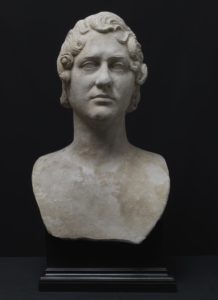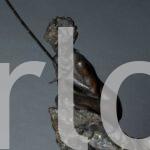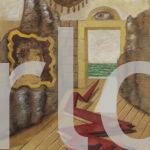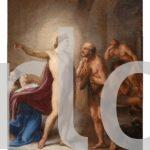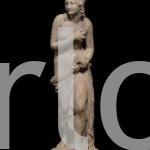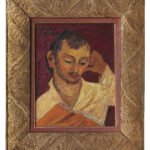| NOT AVAILABLE
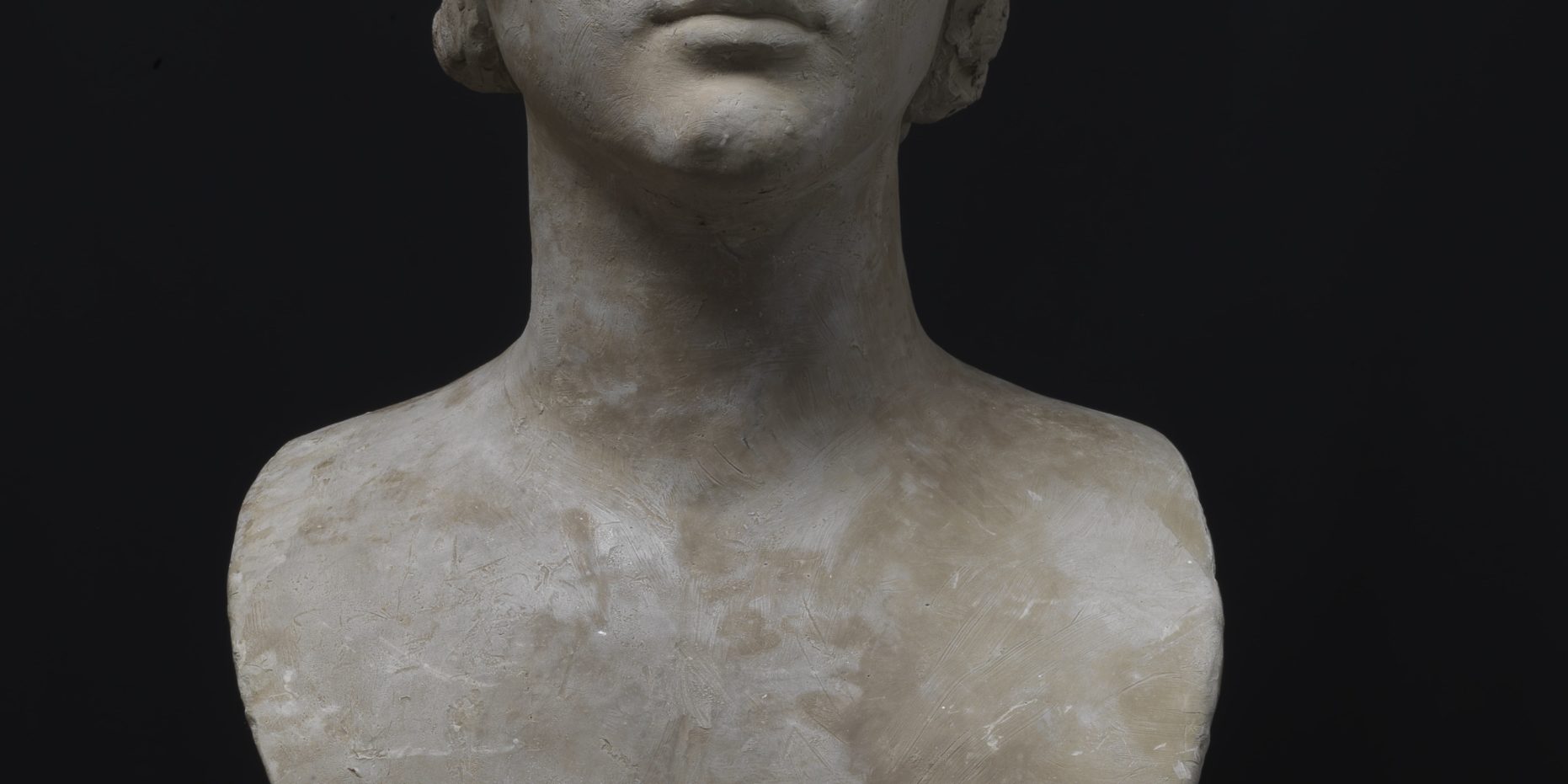
Savignano di Prato 1777-Florence 1850)
George Gordon VI Duke of Byron
1822
Dried raw clay (terracruda), h 50 cm
Provenance: Milan, private collection
From the sources we know that on January 3, 1822 Byron, then in Pisa, posed for Bartolini who had expressed a wish to do his portrait. The poet had accepted the request but on condition that the sculptor also did one of his beloved Teresa Gamba Guiccioli, who had accompanied him during his stay in Pisa. The work on the two busts proceeded very quickly, as it appears that the two marbles were already completed by the following October, but they remained in Bartolini‘s studio for a long time because we know that some years later, certainly after the poet’s death in Greece in 1824, they were seen by Countess Gamba Guiccioli during a visit to the sculptor’s studio; subsequently, in ways still unknown, they were in the possession of Byron’s banker in Genoa, Charles Barry, and after his death, at the behest of the heirs, both were shipped to South Africa and then placed in the South African Library of Cape Town (for this information and related documents see the present writer’s entry in Lorenzo Bartolini 1978, pp. 74-75). From the two very fine plaster moulds, both held by the Gipsoteca Bartolini of the Galleria dell’Accademia in Florence, many versions and replicas have been derived, for which see, most recently, the entries by Maddalena De Luca Savelli and Silvestra Bietoletti, respectively for the marble busts of Byron and of Guiccioli Gamba (in Lorenzo Bartolini 2011, pp. 226-230).
This raw clay (terracruda) bust, entirely unknown to scholarship and coming from a private Milanese collection, is a precious testimony (as well as rare because in the process of moulding the plaster the clay model was destroyed or in any case discarded) of a passage in the making of the portrait of the a poet that, according to the known sources, was concluded in a few months, contrary to the habits of the sculptor who was notoriously slow in fulfilling the commissions received.
The work appears to be cited by a direct source, Thomas Medwin who, in his Conversations of Lord Byron set down during his stay in Pisa, recorded comparing the physiognomy of the poet to his own portrait in words the very likeness of Bartolini’s bust in clay, having being present in person at the posing during the modelling sessions.
“Being with him, day after day, sometime afterwards, whilst he was sitting to Bertolini [sic], the Florentine sculptor for his bust, I had an opportunity of analysing his feature more critically, but found nothing to alter in my portrait. Bartolini‘s is an admirable likeness, at least was so in the clay model. I have not seen it since it was copied in marble, nor have I got a cast; he promised Bertolini should send me one. Lord Byron prided himself on his neck; and it must be confessed that his head was worthy of being placed on it. Bertolini destroyed his ébauches more than once before he could please himself. Lord Byron said, “It is the last time I sit to sculptor or painter.” This was on the 4th of January 1822 (Medwin 1824, p.5).
It is interesting to note that it corresponds in dimensions to the plaster model of the Galleria dell’Accademia, 65 cm high with the pedestal, 48 without, measurements analogous to that of the known marble versions, but not to those of some derivations of smaller size, all studio replicas, which are about 38-39 cm tall, as in the small marble being presented also on this occasion. However, the clay model differs from the plaster model in the details of the modelling. It must be inferred that Bartolini, after having quickly moulded this bust in clay, probably in Pisa in January 1822 as described by the source cited, and, given the impossibility of shaping it in plaster far from Florence, leaving it intentionally to dry out in, used it as exemplar for the making in the studio of a second clay model – with a different finish suited to the final version – which was then used by him to shape the plaster for mapping across points for the working of the marble.
Comparison of the clay bust with the Accademia model reveals some significant differences in the upper part of the hair, which here appears more simplified than what we see in the plaster and in the known marble versions, which in this particular are all substantially similar. This simplification is evident above all in the lateral view of the bust, which reveals skilful treatment of the hair, rapid and sweeping. Similar treatment also characterizes the cut of the eyes and lips that appear more “natural” in the plaster than the slight abstraction felt in the clay model. The expressive motif of the slight frown in the eyebrows is rendered here not in protuberant relief as in the plaster, but through the drawing of the furrow incised by the stick. Moreover, the face is more rounded than in the Accademia model, and the dimple in the poet’s chin is less pronounced compared with the plaster and marble versions.
Except for these slight differences, the formal treatment of the poet’s features is quite similar to that of the many male portraits done by Bartolini, both before and after that of Byron. For example, constant elements of his portraiture, evident above all in the plaster models, are the deep-set cut of the eyes and the very firm cut of the lips; and again the treatment of the hair, always more summary in the models compared to the respective versions in marble (see, among the many possible examples of male portraits, those in plaster of Francesco Benedetti, Govan Battista Niccolini, Rossini, Pius IX in the catalogue Lorenzo Bartolini 1978, respectively on pp. 70, 81, 85, 90).
For the reasons given, therefore, the work is important testimony of the start of the process of making one of the most significant portraits done by Bartolini, and at the same time is truly rare in its material characteristics, making it a unicum among the sculptor’s works.
Ettore Spalletti
Lorenzo Bartolini 1978
Lorenzo Bartolini. Mostra delle attività di tutela, exhibition catalogue, (Prato February-May 1978), Florence 1978.
Lorenzo Bartolini 2011
Lorenzo Bartolini, scultore del Bello Naturale, exhibition catalogue (Florence 31 May – 6 November 2011) edited by F. Falletti, S. Bietoletti, A. Caputo, Firenze 2011.
Medwin 1824
Thomas Medwin, Conversations of Lord Byron noted during a residence with his Lordship at Pisa in the years 1821 and 1822, London 1824.
The Carlo Virgilio & C. Gallery searches for works by Bartolini Lorenzo (1777-1850)
To buy or sell works by Bartolini Lorenzo (1777-1850) or to request free estimates and evaluations
mail info@carlovirgilio.co.uk
whatsapp +39 3382427650
